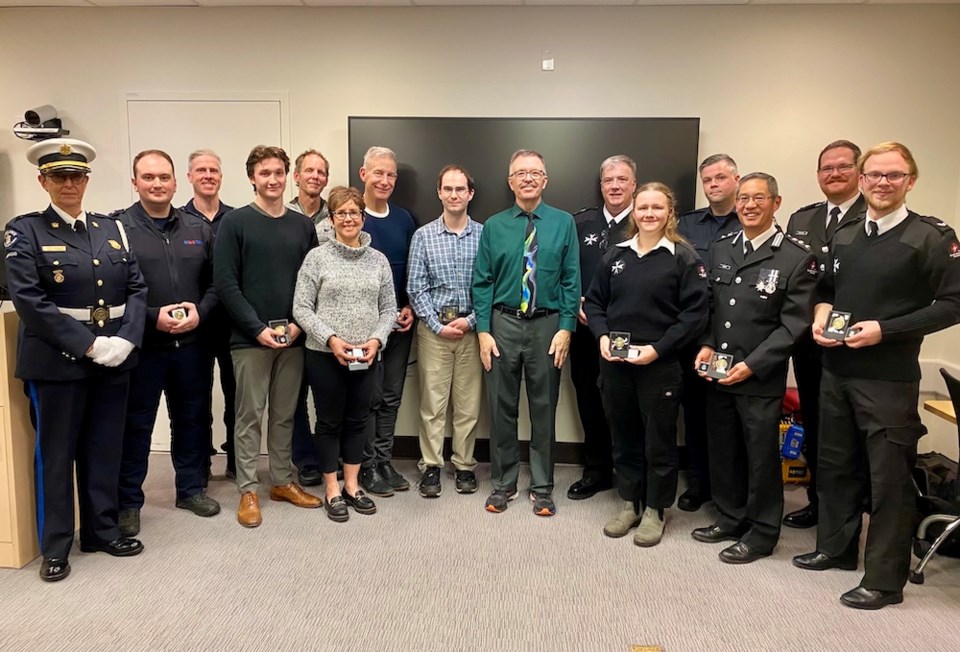Michael Bohonos planned every aspect of his Royal Victoria Marathon run in October, envisioning every possible twist and turn — except one: that his heart would stop six kilometres into an eight-kilometre race.
Over the course of his two-hour resuscitation, he’d be revived many times.
At an awards ceremony at Royal Jubilee Hospital on Wednesday, the race team’s volunteer medics, St. John Ambulance volunteers, B.C. Ambulance paramedics, firefighters, emergency department doctors and cardiac specialists joined in a rare gathering punctuated by tears and laughter as they met one another and shared their part in the larger story of saving Bohonos’s life.
Bohonos, 68, a retired accountant and avid runner, remembers the rituals of putting on his carefully laid out race attire, exiting his parked car at 6:45 a.m., and heading toward the Inner Harbour for the 7:15 a.m. race start.
“The morning of the race I felt really good, I felt no pain, and I was thinking it’s another good day to run in paradise,” said Bohonos.
Three days later, Bohonos awoke with no memory of the race. He had broken ribs, a broken sternum and a punctured lung suffered during his rescue effort, but he was able to tell family where he had parked his car on Douglas Street.
Six days later, he left hospital.
Critical care physician Dr. Omar Ahmad, Island Health department head for emergency and critical care, said Bohonos had a blockage in one of the main coronary arteries, which caused him to collapse and go into full cardiac arrest.
Ahmad, also the medical director for B.C. Emergency Health Services, noted 60,000 Canadians suffer an out-of-hospital cardiac arrest every year and only one in 10 survive. Fewer do so without brain damage.
“Mike Bohonos is the poster child for how a community of providers came together to bring Mike back to life and bring him back in spectacular fashion,” said Ahmad.
“He’s back to his previous state of health and mental well-being and neurologically preserved, and cardio-pulmonary resuscitation and automated external defibrillator use up front was a key factor to this success story,” he said.
Dr. Doug McGhee, an addictions specialist who volunteers for the race team’s bike crew, said when he and University of B.C. medical student Liam King were alerted to trouble by Dallas Road bystanders, they pedalled ahead to find Bohonos on the ground, his face purple. McGhee said it was “showtime.”
McGhee radioed in a seizure followed by full cardiac arrest. St. John Ambulance dispatcher Ron Schiefer was in a radio room with five agencies who shared the information and dispatched crews immediately.
King, who had never performed CPR on a real patient, started chest compressions with textbook precision, according to McGhee, who managed the patient’s airway.
McGhee expressed almost disbelief at how St. John Ambulance volunteers RCAF Cpl. Adam Weddel and University of Victoria mechanical engineering student Michael Ralf so naturally slid into place.
“We got off our bikes right when he said, ‘We don’t have a pulse,’ ” said Ralf.
Ralf cut off Bohonos’s shirt to prepare his chest for the AED patches and Weddel delivered two shocks.
The heart is a mechanical and electrical device. CPR is used to replace the function of the heart to maintain blood flow, blood glucose and oxygen to the brain and vital organs while an AED is used to restore a normal heart rhythm.
B.C. Emergency Health Services paramedic Noel Morton said everything was in hand by the time he arrived to the large gathering, noting the Victoria Fire Department was also on the scene.
En route to the hospital, Bohonos was intubated and everything looked good “until we got to the doors of the hospital” when Bohonos went back into ventricular fibrillation.
“We ended up shocking [him] in the hallway and started CPR again,” said Morton.
At that point, emergency department physician Dr. James Thompson stepped in to the controlled chaos, describing Bohonos as “very unstable.” Bohonos was in what’s called an “electrical storm” and would be shocked again.
“Everybody got to push the [defibrillator] button,” he quipped.
Thompson described a type of magic and excitement when people from different disciplines come together as a team focused on one task — to save a life.
“It’s humbling to be part of that team,” he said.
Bohonos was then taken to the cardio catheterization lab where interventional cardiologist Dr. Simon Robinson inserted a stent into Bohonos’s blocked artery. Bohonos was then passed on to cardiologist Dr. Lauren Dewart.
Dewart said when patients come to her she is prepared. In congratulating the team, she said she could never imagine being a first responder and having to apply what she knows in a “completely different environment with everything moving and no diagnosis.”
She noted the trauma-bay nurses’ calm work and communication “was stunning to me.”
“It was really actually moving,” she said, referring to it as a ballet.
Dewart said CPR practice can seem “performative” at times but does save lives. As for the CPR that saved both Bohonos’s life and brain function but broke his ribs, she said: “The more broken you are, the smarter you wake up.”
St. John Ambulance officer Nic Hume said the first responders who saved Bohonos’s life came from half a dozen agencies across the city. The first few people to help Bohonos had never done CPR on a live patient before, and the first 10 people were volunteers.
Bohonos said he’s taking life easy as he recovers, walking instead of running, and enjoying more gratitude.
“I appreciate fresh air more, food more, and I see the sun rise early in the morning now and I go ‘wow.’ ”



